XuLA/XuLA2
http://www.xess.com/prods/prod048.php XuLA
http://www.xess.com/prods/prod055.php XuLA2

http://www.xess.com/manuals/XuLA-manual.pdf
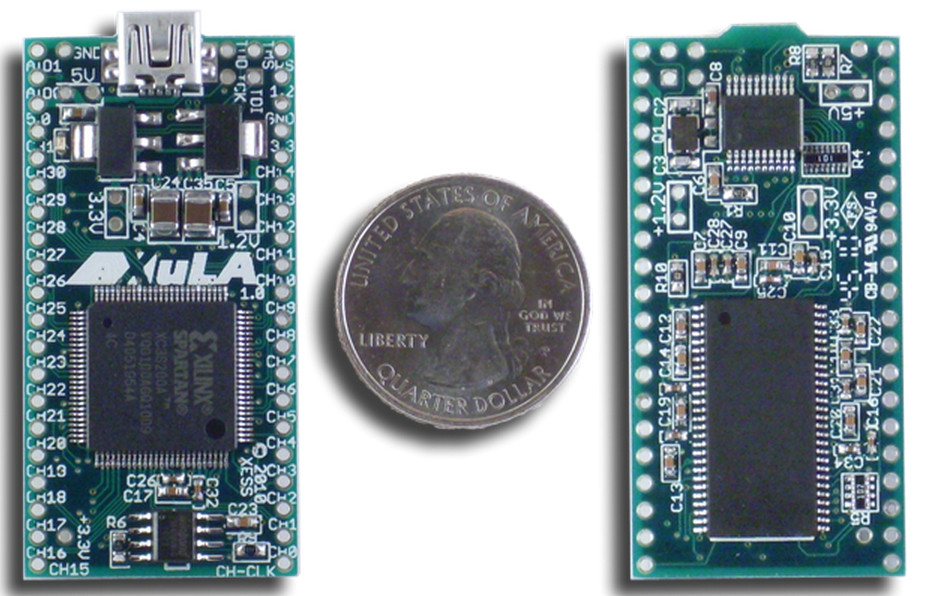


FPGA
The programmable logic device on the XuLA Board is either a XILINX 200,000-gate
XC3S200A Spartan 3A FPGA in a 100-pin VQFP, or a 50,000-gate XC3S50A.
Microcontroller
The XuLA Board uses a Microchip 18F14K50 PIC to perform the following functions:
Reset & initialization: Upon power-up or assertion of the reset, the microcontroller
initiates the configuration of the FPGA from the Flash and holds the FPGA in its
cleared state if the configuration fails. It instantiates its USB endpoints and
participates in the USB enumeration process.
Clock generation: The microcontroller uses its pulse-width modulation (PWM) circuitry
to generate a 12 MHz square-wave that enters one of the FPGA's global clock
inputs.
USB-to-JTAG communication: The microcontroller accepts configuration bitstreams and
data as packets over the USB link and transforms these into a sequence of
transitions upon the FPGA's JTAG pins. It also receives data from the FPGA
through the JTAG port which it bundles into packets for return through the USB
link.
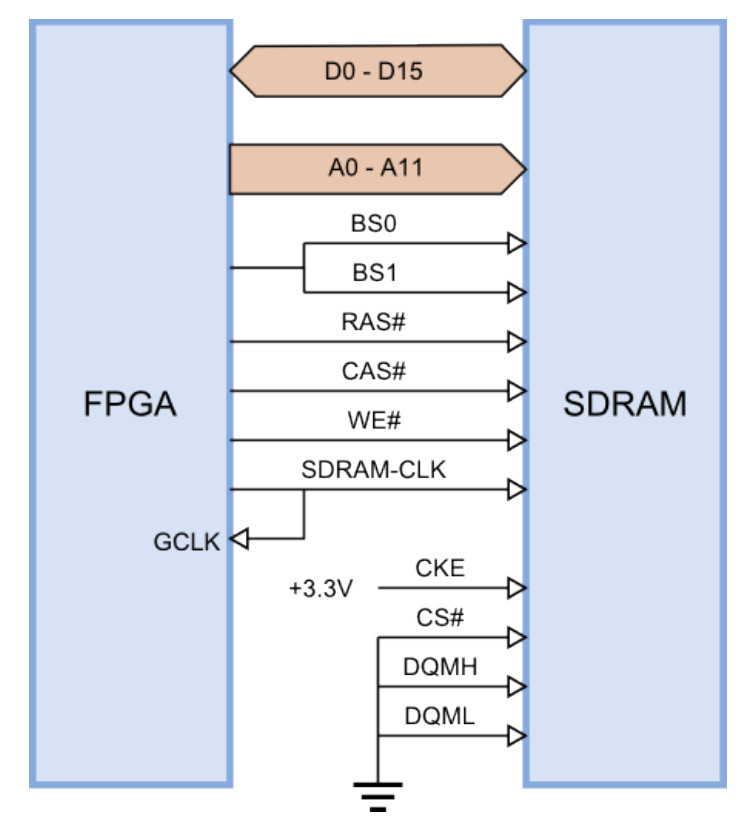
SDRAM
The XuLA Board incorporates an 8M x 16 SDRAM (Winbond W9812G6JH) that connects to
the FPGA as shown below. To compensate for circuit delays, the clock signal to the
SDRAM is re-routed back to a global clock input so the FPGA can synchronize itself with
the SDRAM.
Because of the limited number of pins provided by the FPGA's package, the following
modifications were made to the SDRAM interface:
The chip-select (CS#) is tied low so the SDRAM is always enabled.
The clock-enable (CKE) is tied high so the SDRAM always requires a clock signal in
order to keep its data refreshed.
Both data qualifier mask enables (DQMH and DQML) are tied low to disable byte-wide
access to the SDRAM, so all operations involve the entire sixteen-bit data width.
A single FPGA pin drives both bank-select inputs (BS0 and BS1). This reduces the
accessible region of the SDRAM by half to 4M x 16.
Flash
The XuLA Board has a 2-Mbit SPI Flash (Winbond W25X20BV) that connects to the FPGA
as shown below.
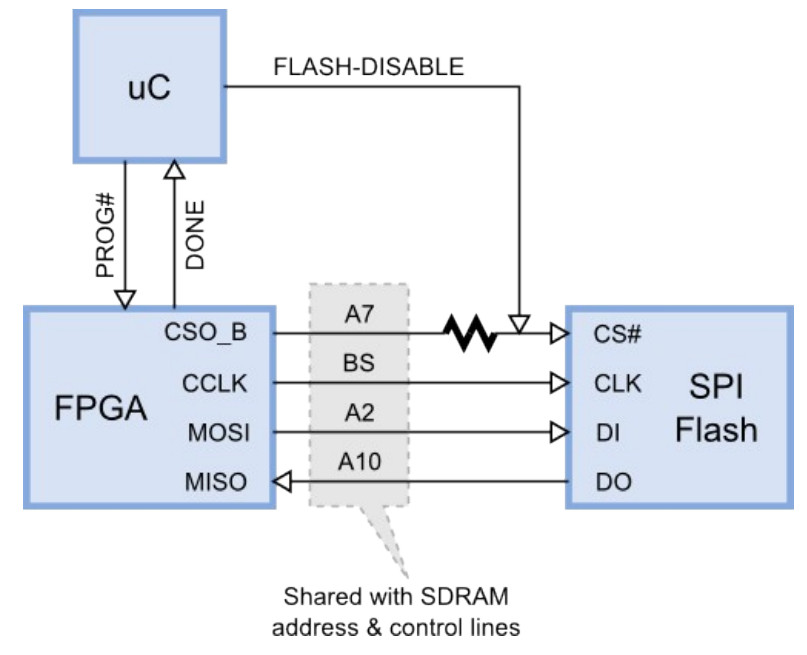
Due to the limited I/O of the FPGA package, the Flash and SDRAM chips share some of
the FPGA pins. In combination with the SDRAM being permanently enabled (its chip-select
is always asserted), this means that the Flash and SDRAM cannot be used simultaneously.
Therefore, the following events occur when the XuLA Board comes on:
1. The microcontroller puts its FLASH-DISABLE output into a high impedance state and
pulses the FPGA's PROG# pin to initiate the configuration from the Flash.
2. The FPGA lowers its CSO_B pin to enable the Flash, and then uses its CCLK, MOSI and
MISO pins to read the stored bitstream. Because the SDRAM is not active during the
FPGA's configuration (SDRAM-CLK is inactive since the FPGA is not configured), it
doesn't matter if the SDRAM address and control pins are toggling.
3. Once the Flash delivers its bitstream, the FPGA's DONE pin is asserted. The
microcontroller senses this and drives its output pin high to de-assert the FLASHDISABLE signal,
thus turning the Flash off. The FPGA can't access the Flash any more,
but it can access the SDRAM without affecting the Flash.
It is possible to set a flag that prevents the microcontroller from disabling the Flash after
the FPGA is configured (as described here). Then the logic design loaded into the FPGA
can access the Flash, but it can no longer use the SDRAM (the toggling of the SDRAM
address and control pins might inadvertently corrupt the Flash contents).
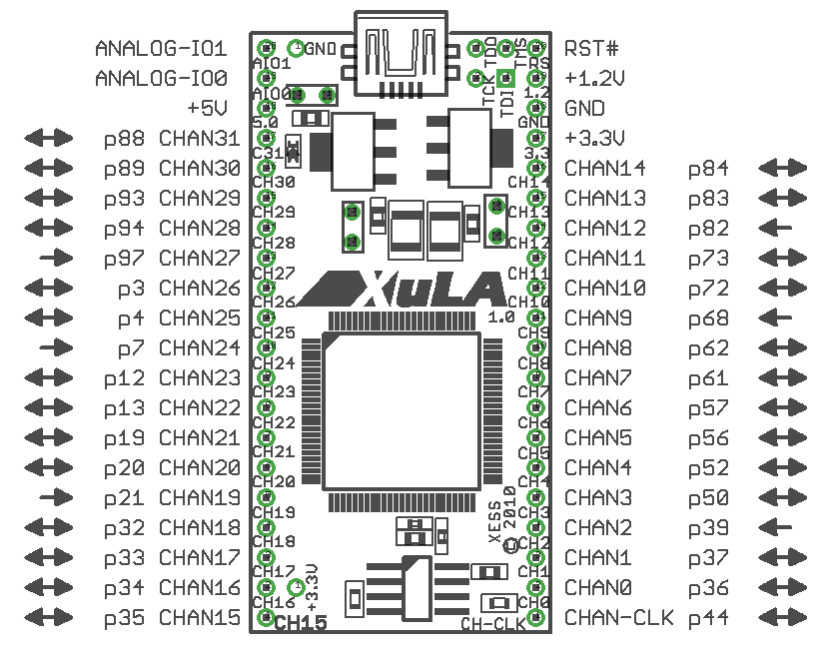
5V Tolerance Issues
The CHAN* and CHAN-CLK pins connect directly to the pins of the FPGA which typically
use an I/O voltage of 3.3V. When driving the inputs of external 5V logic, you should check
that their VIH threshold is less than the VOH of the XuLA outputs. (This is true for most 5V
logic families.)
You must also take care not to exceed the input voltage rating of the FPGA pins when
they are driven by external 5V logic outputs. A common technique for protecting the
Xilinx FPGA pins is shown below. When presented with a voltage greater than 3.3V + 0.7V
= 4.0V, the protection diode built into the FPGA pin's circuitry conducts current and the
excess voltage is dropped across the 100Ω resistor. This keeps the voltage directly on the
FPGA pin from ever exceeding 4V, which is within tolerated limits. The resistor value
should be set so the current through the protection diode does not exceed 10 mA.
However, by default, the Xilinx Spartan-3A FPGA disables the protection diodes.
In order to enable these diodes, you can place the following text into your Xilinx ISE
project constraint file for every I/O pin that will be connected to 5V logic:
NET "input_name" IOSTANDARD = PCI66_3;

http://www.xess.com/manuals/XuLA2-manual.pdf
XuLA2 is an open-source FPGA development board, based on Xilinx Spartan-6 LX25 low cost FPGA.
The design provides 32MB SDRAM, micro-SD card slot, two voltage regulators, supervisory circuitry
based on PIC 18F14K50 microcontroller and USB port for programming the FPGA.


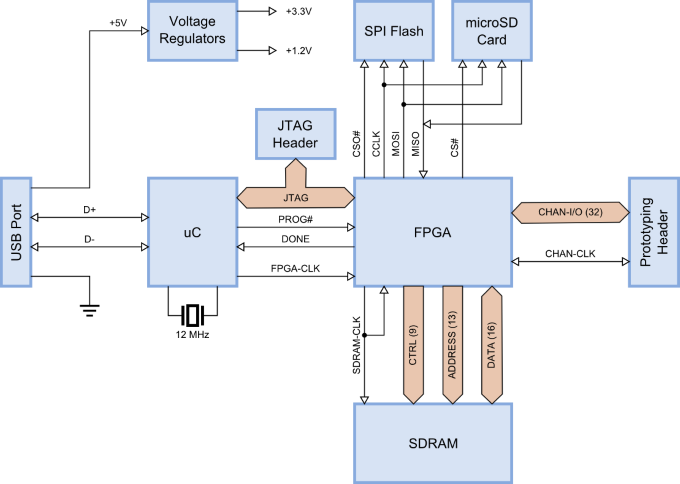
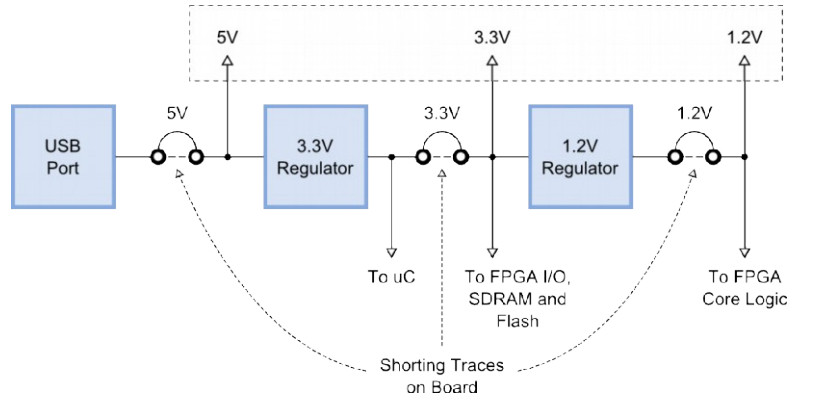
FPGA
The programmable logic device on the XuLA2 is a XILINX XC6SLX25 Spartan 6 FPGA in a
256-ball BGA package (FT256).
Microcontroller
The XuLA2 uses a Microchip 18F14K50 PIC to perform the following functions:
Reset & initialization: Upon power-up or assertion of the reset, the microcontroller
initiates the configuration of the FPGA from the SPI Flash and holds the FPGA in
its cleared state if the configuration fails. It instantiates its USB endpoints and
participates in the USB enumeration process.
Clock generation: The microcontroller uses its pulse-width modulation (PWM) circuitry
to generate a 12 MHz square-wave that enters one of the FPGA's global clock
inputs.
USB-to-JTAG communication: The microcontroller accepts configuration bitstreams and
data as packets over the USB link and transforms these into a sequence of
transitions upon the FPGA's JTAG pins. It also receives data from the FPGA
through the JTAG port which it bundles into packets for return through the USB
link.
SDRAM
The XuLA2 incorporates a 16M x 16 SDRAM (Winbond W9825G6JH) that connects to the
FPGA as shown below. To compensate for circuit delays, the clock signal to the SDRAM is
re-routed back to a global clock input so the FPGA can synchronize itself with the SDRAM.
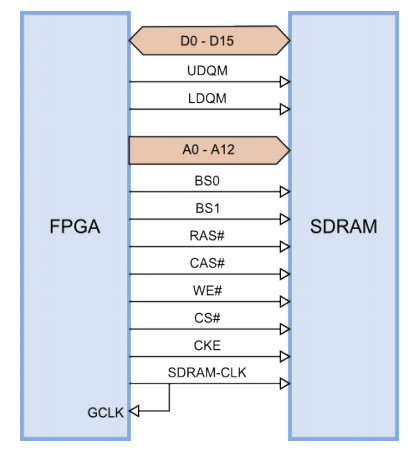
SPI Flash and microSD Card
The XuLA2 has an 8-Mbit SPI Flash (Winbond W25Q80BV) and a microSD card socket that
connect to the FPGA as shown below. During FPGA configuration, the bitstream is read
from the SPI flash while the microSD card is disabled. After configuration, either the SPI
Flash or the microSD card can be accessed by lowering their respective chip-selects and
performing SPI read/write operations.
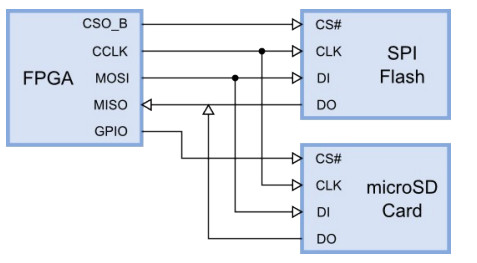
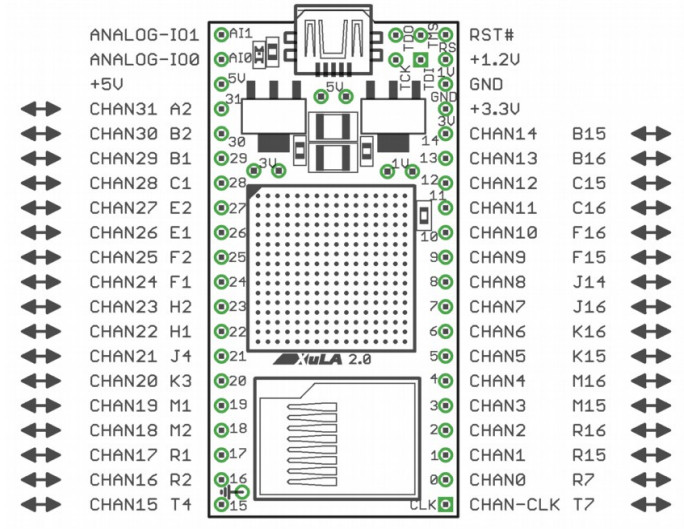
XuLA/XuLA2的更多相关文章
- Unity3D|-XLua热更新用法的大致流程
xlua是由腾讯维护的一个开源项目,我们可以在github上下载这个开源项目并查看一些相关文档 官网:https://github.com/Tencent/xLua 配置文档:https://gith ...
- miniSpartan6, another Spartan 6 Kit
http://thehardwarer.com/2013/05/minispartan-6-another-spartan-6-kit/ miniSpartan6 is an Opens Source ...
随机推荐
- Spring Cloud Feign 在调用接口类上,配置熔断 fallback后,输出异常
Spring Cloud Feign 在调用接口类上,配置熔断 fallback后,出现请求异常时,会进入熔断处理,但是不会抛出异常信息. 经过以下配置,可以抛出异常: 将原有ErrorEncoder ...
- Java打包问题之一:打包出现java.io.IOException: invalid header field
前言 java的打包工具jar有时候会出一些莫名其妙的问题,比如不合法的头部字段等等.这些问题之前也没注意,因为一直是用eclipse打包.后来在公司的时候,要求统一编写shell脚本来进行打包. 其 ...
- 不修改系统日期和时间格式,解决Delphi报错提示 '****-**-**'is not a valid date and time
假如操作系统的日期格式不是yyyy-MM-dd格式,而是用strtodate('2014-10-01')) 来转换的话,程序会提示爆粗 '****-**-**'is not a valid date ...
- ADO.NET Connection Pooling at a Glance
ADO.NET Connection Pooling at a Glance Establishing a connection with a database server is a hefty a ...
- js求区间随机数
function rnd(n, m){ var random = Math.round(Math.random()*(m-n)+n); return random; }
- Codeforces Round #278 (Div. 1) B - Strip dp+st表+单调队列
B - Strip 思路:简单dp,用st表+单调队列维护一下. #include<bits/stdc++.h> #define LL long long #define fi first ...
- OOD沉思录 --- 面向动作与面向对象 --- 避免全能类
面向过程的软件开发通过非常集中化的控制机制来分解功能,在程序设计中表现就是大量的条件判断,深层次的循环嵌套等. 这种模式下,我们可以通过分析方法的参数,局部变量及其访问的全局变量来得到方法对数据的依赖 ...
- Hadamard product
按元素乘积. python中Hadamard product和matrix product的区分: For numpy.ndarray objects, * performs elementwise ...
- db2部署与数据仓库应用
概念特性 安装 基础命令 连接 监控 存储过程 数据合并 Merge Into是增量备份 结果集分组 row_number() OVER (PARTITION BY COL1 ORDER BY COL ...
- springMVC项目,存中文到mysql是乱码(?????)
问题:jdbc连接mysql数据库,web页面输入的中文,存到数据库却变成"????”: 但是数据库中的中文却能够正常读出并在页面显示 mysql中运行 :SHOW VARIABLES LI ...
